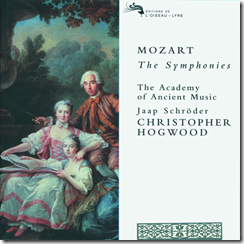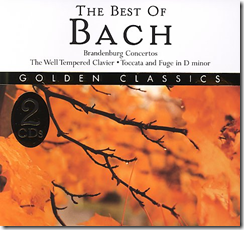Tagging Classic Music albums with Mp3tag for iTunes and Last.fm
I realized a lot of people having trouble with tagging Classic music. Initially, I got into Classical music to take up this challenge but now I am hooked into it because of its nice sophisticated melodies. There has to be a very straight forward way of tagging music. The ID3v2 specification provides us frames for the following tags that can be used to organize classical music:
- Artist
- AlbumArtist
- Conductor
- OriginalArtist
- Composer
- Album
- Name
My goal is to devise a plan to fit all of these tags into Classical music appropriately, so that
- the Classic music composers will appear in Last.fm statistics
- music will be organized and displayed well in iTunes
The primary focus is given to how the music is organized. This means tagging conventions for track names is not one of the primary concerns in this article.
First we familiarise ourselves with the ID3v2 frames for the tags above.
TPE1
The 'Lead artist/Lead performer/Soloist/Performing group' is used for the main artist. This is our Artist tag. In Mp3tag this is %ARTIST%.
TPE2
The 'Band/Orchestra/Accompaniment' frame is used for additional information about the performers in the recording. This is our AlbumArtist tag. In Mp3tag this is %BAND%.
TPE3
The 'Conductor' frame is used for the name of the conductor. Conductor is a person who conducts an orchestra or choir. This is our Conductor tag. In Mp3tag this is %CONDUCTOR%.
TOPE
The 'Original artist/performer' frame is intended for the performer of the original recording, if for example the music in the file should be a cover of a previously released song. This is our OriginalArtist tag. In Mp3tag this is %ORIGARTIST%.
TCOM
The 'Composer' frame is intended for the name of the composer. This is our Composer tag. In Mp3tag this is %COMPOSER%.
TALB
The 'Album/Movie/Show title' frame is intended for the title of the recording (or source of sound) from which the audio in the file is taken. This is our Album tag. In Mp3tag this is %ALBUM%.
TIT2
The 'Title/Songname/Content description' frame is the actual name of the piece (e.g. "Adagio", "Hurricane Donna"). This is our Name tag. In Mp3tag this is %TITLE%.
iTunes, at the time of writing, does not support the following tags:
- Conductor
- OriginalArtist
However we will be populating these frames for future use.
The easiest way to demonstrate the usage of these tags is by examples.
Example 1:
From the cover art, we gather information about the following people/groups.
- Academy of Ancient Music
- Christopher Hogwood
- Jaap Schröder
- Wolfgang Amadeus Mozart
Immediately we realize
Album: Mozart: The Symphonies
The band/orchestra is obviously Academy of Ancient Music.
AlbumArtist: Academy of Ancient Music
Wolfgang Amadeus Mozart composed the music, and also the original artist.
Composer: Wolfgang Amadeus Mozart
OriginalArtist: Wolfgang Amadeus Mozart
Christopher Hogwood and Jaap Schröder conducted the band/orchestra.
Conductor: Christopher Hogwood, Jaap Schröder
What to use for Artist is the biggest argument in Classical Music. Last.fm only scrobbles Artist tag. It does not yet scrobble original artist or composer tag. For useful and meaningful charts, we require Last.fm to scrobble original artist e.g. Wolfgang Amadeus Mozart.
Artist: Wolfgang Amadeus Mozart
Example 2:
Artist: Ludwig van Beethoven
AlbumArtist: London Symphony Orchestra
Album: The Nine Symphonies
Composer: Ludwig van Beethoven
Conductor: Josef Krips
Example 3:
Compilation Discs such as "Best of" will cause a disc to have multiple bands according this logic. However, to keep all the tracks in the album organized under one album folder, it is recommended to use "Various Artists" in the AlbumArtist tag if this is the case.
Artist: Johann Sebastian Bach
AlbumArtist: Various Artists
Album: The Best of Bach
Conductor: Hans Swarowsky
For tagging Name, follow MusicBrainz conventions.
-
Catalogue: number and opus
-
Always use "No. " and "Op. " Examples:
-
'Symphony No. 5 in C minor, Op. 67'. Note the spaces after the stop character, and the use of comma (i.e. "No. 5", not "No.5" and "Op. 67", not "Op.67").
-
'Mazurka in B major, Op. 63 No. 1'. Here the 'No. 1' is a subpart of 'Op. 63'. Note that there's no comma between them.
-
-
-
Chord: minor and major
-
Always use the expanded form and lowercase including a hyphen for German. Examples:
-
'Violin Concerto in D minor, Op. 47' (English)
-
'Prélude No. 1 C-dur, Op. 28: Agitato' (German)
-
-
-
Keys
-
Always use uppercase for English and German notation "A, B, C, D, E, F, G" and proper case for Italian (and French and Spanish) "Do, Re, Mi, Fa, Sol, La, Si". Attribute "in", "en" or "em" should be inserted according to release language. Examples:
-
'Trio in A minor, Op. 50;' (English)
-
'Prelude and Fugue in F-sharp major, BWV 858' (English)
-
'Concerto No. 1 in Sol minore, Op. 8, RV 332' (Italian)
-
'Concerto No. 4 en La mineur' (French)
-
'Prélude No. 2 A-moll, Op. 28: Lento' (German)
-
'Prélude No. 8 Fis-moll, Op. 28: Molto agitato' (German)
-
-
For more combinations refer to
English Musical Keys and to the complex
German notation
-
-
Italian tempo markings
-
Since they are Italian they should follow CapitalizationStandardItalian such that only the first letter of the phrase is titled. Example:
-
'Concerto for Piano and Orchestra No. 5 in D major, KV 175: II. Andante ma un poco adagio'
-
-
-
Common names
-
Common works names can be omitted, yet it's preferable to add them. They have to be entered within double quotes:
-
'Piano Sonata No. 23 in F minor, Op. 57 "Appassionata": II. Andante con moto' (do not use 'Appassionata' or «Appassionata» or -Appassionata-)
-
'String Quartet No. 17 in B-flat major, KV 458 "Hunt": II. Moderato'
-
'Sinfonie in e-moll, Op. 95 "Aus der Neuen Welt": II. Largo'
-
'Cantata, BWV 17 "Wer Dank opfert, der preiset mich": Part II, V. Aria "Welch Übermaß der Güte"'. Same as before, but note that it also applies to the very track title.
-
-
-
Vocalists
-
Entering vocalists (tenor, soprano, bass) is not mandatory. They are entered after the track name, but before the common name if present:
-
'Cantata, BWV 17 "Wer Dank opfert, der preiset mich": Part II, V. Aria (Tenor, Soprano) "Welch Übermaß der Güte"'
-
-




Comments
One thing however: you write that it is difficult to correctly tag classical music. This, in my humble opinion is NOT true.
It is difficult (if not impossible!) to tag both pop and classical music in such a way that they both make sense on a, say, mp3 player.
I do personally NOT mind about the orchestra I am listening to, most important is the composer. So THAT is the name I use for "artist", since, Beethoven is what I look out for when searching his Ninth Symphony, played by the Berliner Philharmoniker. MP3 players do not know about composers. They only know about artists.
It is not the tags that cause the troubles, nor the tagging programmes, but the players....